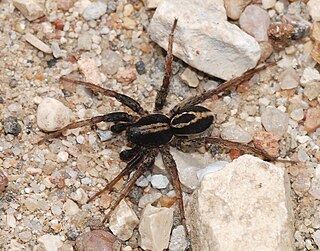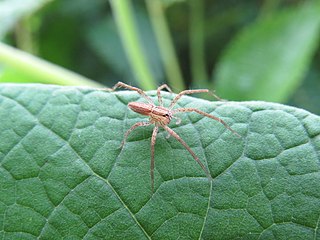
Trechaleidae (tre-kah-LEE-ih-dee) is a family of araneomorph spiders first described by Eugène Simon in 1890, and includes about 140 described species in 16 genera. They all live in Central and South America except for Shinobius orientalis, which is endemic to Japan. Other names for the family are longlegged water spiders and fishing spiders.

Lycosoidea is a clade or superfamily of araneomorph spiders. The traditional circumscription was based on a feature of the eyes. The tapetum is a reflective layer at the back of the eye, thought to increase sensitivity in low light levels. Lycosoids were then defined by having a "grate-shaped" tapetum. Research from the late 1990s onwards suggests that this feature has evolved more than once, possibly as many as five times, so that the original Lycosoidea is paraphyletic. Studies published in 2014 and 2015 suggest that a smaller group of families does form a clade.

The Entelegynae or entelegynes are a subgroup of araneomorph spiders, the largest of the two main groups into which the araneomorphs were traditionally divided. Females have a genital plate (epigynum) and a "flow through" fertilization system; males have complex palpal bulbs. Molecular phylogenetic studies have supported the monophyly of Entelegynae.
Palaeoperenethis is an extinct monotypic genus of Nursery web spider family Pisauridae, and at present, it contains the single species Palaeoperenethis thaleri. The genus is solely known from the Early Eocene, Ypresian Okanagan Highlands deposits in the Cariboo region of British Columbia, Canada.

The RTA clade is a clade of araneomorph spiders, united by the possession of a retrolateral tibial apophysis – a backward-facing projection on the tibia of the male pedipalp. The clade contains over 21,000 species, almost half the current total of about 46,000 known species of spider. Most of the members of the clade are wanderers and do not build webs. Despite making up approximately half of all modern spider diversity, there are no unambiguous records of the group from the Mesozoic and molecular clock evidence suggests that the group began to diversify during the Late Cretaceous.
Trechalea is a genus of spider in the family Trechaleidae, found in the United States to Peru and Brazil.
Amapalea is a monotypic genus in the spider family Trechaleidae. It was first described in 2006 by Silva & Lise. As of 2017, it contains only one Brazilian species, Amapalea brasiliana.
Barrisca is a genus of spiders in the family Trechaleidae. It was first described in 1936 by Chamberlin & Ivie. As of 2017, it contains 2 species.
Caricelea is a genus of spiders in the family Trechaleidae. It was first described in 2007 by Silva & Lise. As of 2017, it contains 3 species, all from Peru.
Dossenus is a genus of spiders in the family Trechaleidae. It was first described in 1898 by Simon. As of 2017, it contains 3 species.
Heidrunea is a genus of spiders in the family Trechaleidae. It was first described in 1994 by Brescovit & Höfer. As of 2017, it contains 3 species, all from Brazil.
Hesydrus is a genus of spiders in the family Trechaleidae. It was first described in 1898 by Simon. As of 2017, it contains 7 Central and South American species.

Neoctenus is a genus of spiders in the family Trechaleidae. It was first described in 1897 by Simon. As of 2017, it contains 4 South American species.
Paradossenus is a genus of spiders in the family Trechaleidae. It was first described in 1903 by F. O. Pickard-Cambridge. As of 2017, it contains 13 species.
Paratrechalea is a genus of spiders in the family Trechaleidae. It was first described in 2005 by Carico. As of 2017, it contains 7 species from Brazil, Argentina, Uruguay.
Rhoicinus is a genus of spiders in the family Trechaleidae. It was first described in 1898 by Simon. As of 2017, it contains 10 species, all from South America.
Shinobius is a genus of spiders in the family Trechaleidae. It was first described in 1991 by Yaginuma. As of 2017, it contains only one Japanese species, Shinobius orientalis.

Syntrechalea is a genus of spiders in the family Trechaleidae. It was first described in 1902 by F. O. Pickard-Cambridge. As of 2017, it contains 12 species.
Trechalea gertschi, the long-legged water spider, is a species of true spider in the family Trechaleidae. It is found in the United States and Mexico.
Enna is a genus of South American and Central American araneomorph spiders in the family Trechaleidae, first described by Octavius Pickard-Cambridge in 1897.





